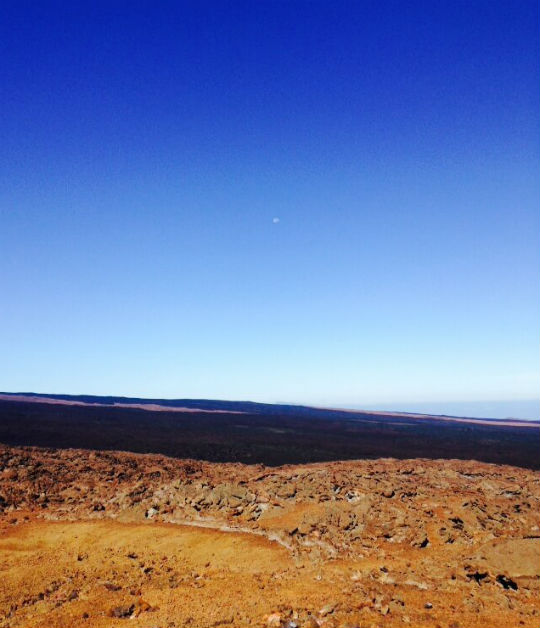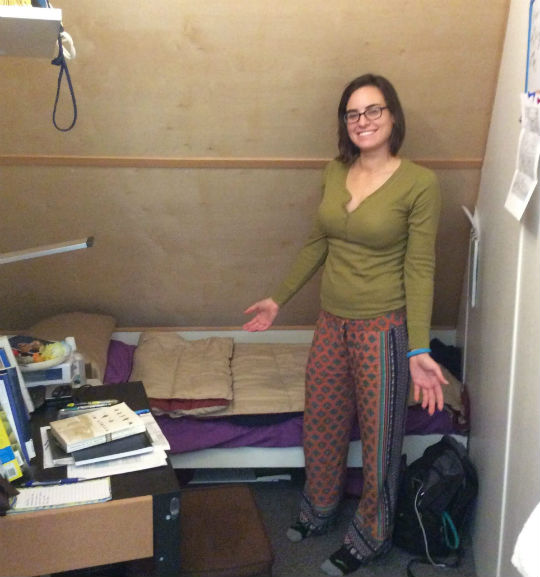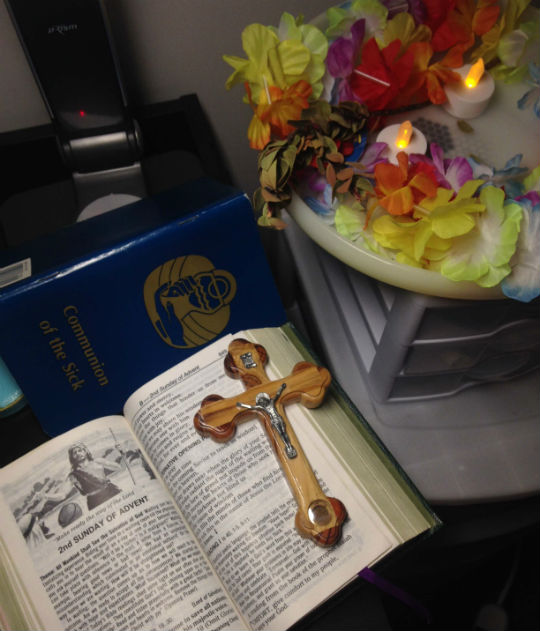View of the terrain at the site of the simulated Mars mission called Hawaii Space Exploration Analog and Simulation (HI-SEAS) at an elevation of 8,200 feet on Mauna Loa volcano. Jocelyn Dunn Photo
Jocelyn Dunn grew up in Sebring, Fla., about two and a half hours from NASA’s Kennedy Space Center. Her parents would take her to shuttle launches when she was a kid, and Dunn was obsessed with the idea of becoming an astronaut.
A love of math guided her to study engineering and aerospace engineering at Embry-Riddle Aeronautical University in Daytona Beach, where she discovered a passion for the human side of space flight.
“It’s just incredible to think about what astronauts go through and how they’re able to do this and stay healthy,” said Dunn, 28.
“It’s very courageous, but at the same time, I don’t think that astronauts necessarily think of it that way. They’re able to manage the risks and manage their personality and their fears and everything to do this incredible thing.”
The private rooms have twin size beds, small desks, a shelf, and sloped ceilings that make for cozy quarters. Jocelyn Dunn is pictured here in her room.
Dunn went on to study biomedical engineering and data science so she could understand more on the human side of space exploration and spacecraft.
Her goal of becoming an astronaut faced a new and unique test in late 2014, when she joined five other crewmembers for the Hawaii Space Exploration Analog and Simulation (HI-SEAS) mission, an eight-month project that simulated what it would be like to live on Mars.
Dunn and her colleagues crammed into an 11-metre-wide dome on the northern slope of the Mauna Loa volcano in Hawaii, where they slept, conducted research and exercised in a space of about 93 square metres (1,000 square feet).
The idea was to study the social, interpersonal and cognitive factors that affect a team during long-duration space travel, such as a two- to three-year mission to Mars.
Would the group stay friends and not go crazy? Would they work well together? How much sleep would they need?
“HI-SEAS definitely focused more on the psychology and the social aspects, but also some of the logistics,” Dunn said. “Like how much entertainment would people need? How do you keep them interested in the food that [was] just a stock inventory of freeze-dried and shelf table ingredients?”
In an effort to maintain appetites for freeze-dried foods, the group was creative with its dinner menus.
“My favourites were pizza night and curry dishes,” Dunn said. “We also had some amazing ‘barbeque’ in the dome, adding liquid smoke to our rehydrated chicken for flavour.”
Advent “wreath” consisting of a frisbee, Hawaiian lei, and battery-powered candles that were “lit” on each of the four Sundays before Christmas. Jocelyn Dunn Photo
On the International Space Station, crews have pre-packaged, ready-to-eat meals, she added.
“HI-SEAS supports the notion that a Mars crew may benefit from having more traditional meal preparation in a small kitchen with shelf-stable ingredients and fresh food from indoor gardening.”
The group had a small garden in its lab that produced lettuce, herbs, and tomatoes.
Dunn, who is now a PhD candidate in industrial engineering at Purdue University, was prepared for the logistics of what daily life would be like in the dome–what she’d be giving up, what might be challenging, she said.
The most difficult part of the experience was staying in touch with family and friends. There was a 20-minute delay in communications, to mimic what it would be like to send an email from Mars back to Earth.
“This changes the dynamics completely, because you can’t have a real time conversation,” Dunn said. “It’s basically the effect of sending a letter in the mail, because you don’t get a reply for so long.”
The collection of supportive cards and photos from Dunn’s family and friends that were included in four resupplies over the course of the eight-month mission. Jocelyn Dunn Photo
There was camaraderie among the researchers, but Dunn admitted they also got on each other’s nerves.
“I think the major way that we dealt with it is having a high level of communication and openness, so that any of the issues that might be going on, would be brought up and not fester over the long-duration of the mission,” she said.
“Every week we would have a debrief together, and we would mainly talk about work—research that we have going on, projects, outreach.
“But also time to reflect on anything that might not be going as we need to support each other on a more emotional level and leadership-wise. So that was really important, and then also keeping a good exercise regimen, because that’s a great way to deal with stress, when you’re having to work through some frustrations or maybe anger, sadness.”
The HI-SEAS mission was in part a process of self-discovery, one that forced the researchers to be honest and accommodating and have high integrity. It also demands an authenticity that has carried over into Dunn’s life after the mission.
“Eight months is … maybe not a significant amount of time for the world to change, but it is a significant amount of time for personal development and growth,” she said.
Post-mission, Dunn saying good-bye to the “dome home” before heading on travels around Hawaiian islands with family members and then on first trip to Europe for TEDx Vicenza conference presentation in Italy. Jocelyn Dunn Photo
“At some point I guess it helped me to start letting go of this tendency to want to control how people perceive me.”
As challenging as it was, living on simulated Mars did not sour Dunn on the idea of going to the real red planet someday, and her dream of becoming an astronaut is still alive.
“I feel like I’m still growing in my research and learning all the time, but I do hope to contribute one way or another,” she said.
“I’d love to go to space, obviously that would be my ideal. But if I can help others to achieve the goals of the human space program, then that’s good.
“Not just good,” she said, catching herself. “That’s great as well.”









